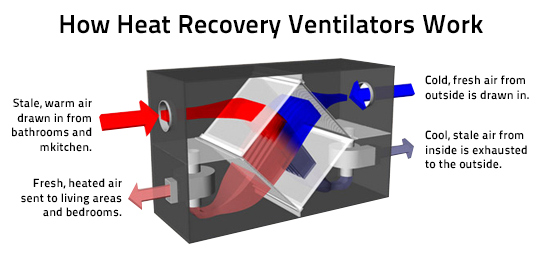How HRV Ensures a Cleaner Indoor Living Environment
Checking out the Perks of Heat Recovery Ventilation for Energy Performance in Houses
Heat Recovery Ventilation (HRV) systems provide homeowners a functional approach to enhancing power efficiency. By recovering warm from outward bound air, these systems can substantially lower cooling and heating prices. Furthermore, they provide a steady supply of fresh air, boosting interior air quality and convenience levels. As homeowners consider sustainable alternatives, understanding the nuances of HRV systems ends up being significantly essential. What factors should one evaluate prior to making such an investment?
Recognizing Heat Recovery Ventilation Solutions

Just How HRV Boosts Indoor Air Quality

Power Savings: The Monetary Benefits of HRV
Making best use of power performance, heat recovery ventilation (HRV) systems use significant monetary benefits for house owners. By recuperating and reusing warm from exhaust air, HRVs substantially decrease cooling and heating prices. This innovation can cause power cost savings of approximately 30%, depending on environment and use patterns. House owners frequently discover lowered energy bills quickly after installment, making HRVs an economically wise investment gradually. Additionally, numerous regions give motivations or discounts for energy-efficient upgrades, even more boosting the financial appeal. As energy rates continue to increase, the cost-effectiveness of HRVs becomes progressively clear. Generally, the consolidation of HRV systems not only advertises power effectiveness however likewise adds to long-term financial savings for houses.
The Environmental Effect of Heat Recovery Ventilation
A significant environmental advantage of heat recovery ventilation (HRV) systems depends on their capability to decrease total energy usage. By reclaiming warm from exhaust air and moving it to inbound fresh air, HRV systems reduce the requirement for energy-intensive heating and cooling down methods. This decrease in energy demand adds to decrease greenhouse gas exhausts, as much less fossil fuel is needed to keep comfortable indoor temperature levels. In addition, HRV systems improve indoor air top quality by effectively exchanging stagnant air with fresh outdoor air, lowering reliance on mechanical additional resources air conditioning systems that can hurt the atmosphere. Generally, the application of HRV systems supports sustainable living practices and lines up with next page worldwide initiatives to deal with environment adjustment by advertising energy efficiency in domestic settings.
Selecting the Right HRV System for Your Home
How can house owners assure they choose the appropriate heat recovery ventilation (HRV) system for their requirements? Initially, they should examine their home's size and format, as these aspects influence air flow requirements. Next off, assessing the system's performance ratings is vital, as greater rankings indicate much better efficiency and energy savings. House owners should additionally think about setup and maintenance costs, comparing various brands and versions for value. Furthermore, it is essential to review noise levels, as some systems operate more quietly than others. Consulting with cooling and heating professionals can offer tailored recommendations based upon details home conditions. Lastly, analyzing individual testimonials and warranties can aid in making a notified decision, making certain that the selected HRV system efficiently boosts indoor air top quality and power effectiveness.
Regularly Asked Questions

Exactly how Usually Should I Clean or Keep My HRV System?
The regularity of cleaning or maintaining a warmth healing air flow (HRV) system generally relies on usage and environmental elements. Usually, it is recommended to execute upkeep every 6 months to assure peak efficiency and air top quality.

Can HRV Systems Help In Reducing Humidity Degrees Inside Your Home?
HRV systems can successfully reduce indoor moisture levels by trading stagnant, moist air with fresh, drier air from outside. HRV Heat Recovery Ventilation. This procedure aids preserve a well balanced interior environment, boosting comfort and avoiding moisture-related issues
What Is the Life-span of a Common HRV System?
The life-span of a regular heat recovery ventilation (HRV) system varies, typically lasting in between 10 to 15 years. Normal maintenance can expand its performance and operational life, ensuring peak performance throughout its usage duration.
Exist Any Type Of Sound Worry About HRV Solutions?
Sound worry about HRV systems can develop, specifically from fan operation. Lots of modern devices are made to minimize sound degrees, ensuring they operate quietly while preserving performance, which deals with possible disruptions in living settings.
Can I Mount an HRV System Myself, or Do I Need a Specialist?
The private contemplated whether to install the heat recovery ventilation (HRV) system directly or employ a professional. Generally, while do it yourself setup is feasible, experience guarantees proper performance and conformity with regional YOURURL.com building regulations, enhancing system performance.